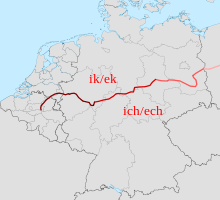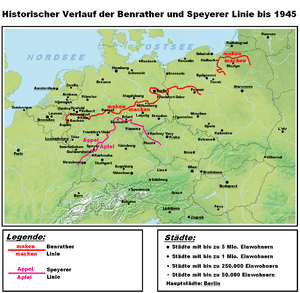German dialects

German dialect is dominated by the geographical spread of the High German consonant shift, and the dialect continua that connect German to some neighbouring languages, e.g. the Dutch and Luxembourgish languages.
Dialects
In relation to varieties of standard German
In German linguistics, German dialects are distinguished from varieties of Standard German.
- The German dialects are the traditional local varieties. They are traditionally traced back to the different Germanic tribes. Many of them are hardly understandable to someone who knows only Standard German, since they often differ from Standard German in lexicon, phonology and syntax. If a narrow definition of language based on mutual intelligibility is used, many German dialects are considered to be separate languages (for example, in the view of Ethnologue). However, such a point of view is unusual in German linguistics.
- The varieties of standard German refer to the different local varieties of the pluricentric language standard German. They only differ slightly in lexicon and phonology. In certain regions they have replaced the traditional German dialects, especially in Northern Germany.
Dialects in Germany
The variation among the German dialects is considerable with only the neighbouring dialects being mutually intelligible. Low German, most Upper German, High Franconian dialects, and even some Central German dialects when spoken in their purest form, are not intelligible to people who know only Standard German. However, all German dialects belong to the dialect continuum of High German and Low German. In the past (roughly until the end of the Second World War), there was a dialect continuum of all the continental West Germanic languages because nearly any pair of neighbouring dialects were perfectly mutually intelligible.
The German dialect continuum is typically divided into High German and Low German. The terms derive from the geographic characteristics of the terrain where they are spoken rather than from social status accorded to them.
Low German
Low German varieties (in Germany usually referred to as "Platt" or "Plattdeutsch") are considered dialects of the German language by some but a separate language by others (then often termed "Low Saxon"). Linguistically Low German (that is, Ingvaeonic) and Low Franconian (that is, Istvaeonic) dialects are grouped together because both did not participate in the High German consonant shift. Low German is further divided into Dutch Low Saxon, West Low German and East Low German.
Middle Low German was the lingua franca of the Hanseatic League. It was the predominant language in Northern Germany, and several translations of the Bible were printed in Low German. This predominance changed in the 16th century. In 1534, the Luther Bible was printed by Martin Luther; this translation is considered to be an important step towards the evolution of the Early New High German. It aimed to be understandable to an ample audience and was based mainly on High German varieties. The Early New High German language gained more prestige than Low Saxon and became the language of science and literature. Other factors included the Hanseatic League losing its importance around the same time (as new trade routes to Asia and the Americas were established) and that the most powerful German states of that period were located in Middle and Southern Germany.
The 18th and 19th centuries were marked by mass education with the language of the schools being standard German. Slowly Low Saxon was pushed back and back until it was nothing but a language spoken by the uneducated and at home. Today, Low Saxon could be divided in two groups: Low Saxon varieties with a sizable standard German influx, and varieties of standard German with a Low Saxon influence (Missingsch).
Today Low Saxon dialects are still widespread, especially among the elderly in the Northern parts of Germany, many of these being able to understand and speak the language, but younger people in Northern Germany are at least able to understand these dialects, though not to speak them. The local media take care not to let the Low Saxon language die out, so there are several newspapers published entirely in this language; other newspapers at least have recurring articles in Low Saxon. The North German Broadcasting (Norddeutscher Rundfunk) also offers TV programs (e.g. "Talk op Platt") and radio programs in Low Saxon.
On the other hand, Northern Germany is considered to be the region where the purest Standard German is spoken, and in everyday life little influence of dialect is heard. Still, there are notable differences in pronunciation even among North German speakers, e.g. lengthening of vowels, differences in accentuation etc. There are also some North German expressions in use even in Standard High German, which are seldom heard in Southern parts (e.g. the word "plietsch" for "intelligent").
High German
High German, that is, Irminonic, is divided into Central German, High Franconian, and Upper German.
Central German dialects include Ripuarian, Moselle Franconian, Central Hessian, East Hessian, North Hessian, Thuringian, North Upper Saxon, Rhine Franconian, Lorraine Franconian, Silesian German, High Prussian, Lausitzisch-Neumärkisch and Upper Saxon. It is spoken in the southeastern Netherlands, eastern Belgium, Luxembourg, parts of France, and in Germany approximately between the River Main and the southern edge of the Lowlands. Modern Standard German is based on Central and Upper German, but the usual German term for modern Standard German is Hochdeutsch, that is, High German.
The Moselle Franconian varieties spoken in Luxembourg have been officially standardized and institutionalized and are therefore usually considered a separate language known as Luxembourgish.
High Franconian dialects are transitional dialects in between the two greater High German groups. High Franconian dialects include East Franconian and South Franconian.
Upper German dialects include Alsatian, Swabian, Low Alemannic, Central Alemannic, High Alemannic, Highest Alemannic, Southern Austro-Bavarian, Central Austro-Bavarian and Northern Austro-Bavarian. They are spoken in parts of the Alsace, southern Germany, Liechtenstein, Austria, and in the German-speaking parts of Switzerland and Italy.
Wymysorys, Sathmarisch and Siebenbürgisch are High German dialects of Poland and Romania.
The High German varieties spoken by Ashkenazi Jews (mostly in Czarist Russia, then the former Soviet Union and Poland) have several unique features, and are usually considered as a separate language, Yiddish. It is the only Germanic language that does not use the Latin script as its standard script. Since it developed in the Danube area, there are some similarities with Central und Upper German dialects in this region.
 Map showing the Uerdingen line, which divides Low German from High German.
Map showing the Uerdingen line, which divides Low German from High German. The Speyer line, dividing the Central German dialects from the High Franconian dialects.
The Speyer line, dividing the Central German dialects from the High Franconian dialects. The Uerdingen and the Karlsruhe line. The Karlsruhe line divides the High Franconian dialects from the Upper German dialects.
The Uerdingen and the Karlsruhe line. The Karlsruhe line divides the High Franconian dialects from the Upper German dialects.
Overseas dialects
The dialects of German that are or were primarily spoken in colonies or communities founded by German speaking people resemble the dialects of the regions the founders came from. For example, Pennsylvania German resembles dialects of the Palatinate, and Hutterite German resembles dialects of Carinthia, whereas Venezuelan Alemán Coloniero is a Low Alemannic variant.
| Standard German | Hunsrik/Hunsrückisch | Low German & Plautdietsch | Pennsylvania Dutch | Hutterite | |
|---|---|---|---|---|---|
| Argentina | 400,000 | N/A | 4,000 | N/A | N/A |
| Australia | 79,000 | N/A | N/A | N/A | N/A |
| Belize | N/A | N/A | 9,360 | N/A | N/A |
| Bolivia | 160,000 | N/A | 60,000 | N/A | N/A |
| Brazil | 1,500,000 | 3,000,000 | 8,000 | N/A | N/A |
| Canada | 430,000 | N/A | 80,000 | 15,000 | 23,200 |
| Chile | 35,000 | N/A | N/A | N/A | N/A |
| Costa Rica | N/A | N/A | 2,000 | N/A | N/A |
| Israel | 200,000 | N/A | N/A | N/A | N/A |
| Kazakhstan | 30,400 | N/A | 100,000 | N/A | N/A |
| Mexico | N/A | N/A | 40,000 | N/A | N/A |
| Namibia | 22,500 | N/A | N/A | N/A | N/A |
| New Zealand | 36,000 | N/A | N/A | N/A | N/A |
| Paraguay | 166,000 | N/A | 40,000 | N/A | N/A |
| Russia | 394,138[2] | N/A | N/A | N/A | N/A |
| South Africa | 12,000 | N/A | N/A | N/A | N/A |
| Uruguay | 28,000 | N/A | 2,000 | N/A | N/A |
| United States | 1,104,354[3] | N/A | 12,000 | 118,000 | 10,800 |
| Sum | 4,597,392 | 3,000,000 | 357,360 | 133,000 | 34,000 |
Amana German
Amana German is a dialect of West Central German. It is spoken in the Amana Colonies in Iowa, which were founded by Inspirationalists of German origin. Amana is derived from Hessian, another West Central German dialect. Amana German is called Kolonie-Deutsch in Standard German.
Brazilian German
In Brazil, the largest concentrations of German speakers (German Brazilians) are in Rio Grande do Sul, where Riograndenser Hunsrückisch was developed, especially in the areas of Santa Catarina, Paraná, and Espírito Santo, as well as in Petrópolis (Rio de Janeiro).
Chilean German
Lagunen-Deutsch is a variety of High German spoken in Chile.
Most speakers of Lagunen-Deutsch live around Lake Llanquihue. Lagunen-Deutsch has integrated elements of the Spanish language. This includes the integration of false cognates with the Spanish language, transferring the Spanish meanings into Lagunen-Deutsch.
The geographical origin of most or all speakers of Lagunen-Deutsch is Chile, to where the ancestors of the speakers immigrated from Europe in the 19th and 20th centuries.
Texas German
German was the main language used in schools, churches and businesses in parts of Texas surrounding Austin and San Antonio.[4] As of October 2013, the Texas German Dialect Project at the University of Texas is recording residual German dialect in central Texas. The dialect is characterised by a loss of lip-rounding on the /yː/ phoneme.[4]
See also
- History of the German language
- German as a minority language
- Ethnic Germans
- Petuh, German vocabulary on a Danish base
- Wisconsin German
References
Further reading
- Friedrich Maurer (1942), Nordgermanen und Alemannen: Studien zur germanischen und frühdeutschen Sprachgeschichte, Stammes- und Volkskunde, Bern: Francke Verlag.
- "German Dialects, Teenagers' Argot: Purists May Disapprove, but Multi-ethnic Dialects Are Spreading", The Economist, no. 8771 (11 Feb. 2012), p. 56. N.B.: Unsigned article, concerning the German urban dialect called "Kiezdeutsh".
External links
- Datenbank fuer Gesprochenes Deutsch (DGD2) - a database with several dialect corpora covering German and overseas (North American, Australian) varieties of German
- An example sentence spoken in different German dialects (German)
- German Dialects - Links, Paul Joyce, University of Portsmouth (extensive collection of links on each dialect)
- Atlas zur deutschen Alltagssprache (University of Augsburg, German) with recent research and maps on everyday language in the German-speaking countries